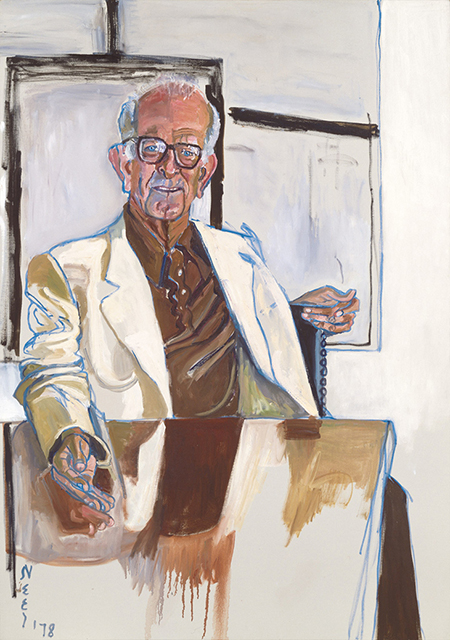
Continuing through November 27, 2021
With the acquisition of 20 New York School paintings and sculptures from the collection of the late Richard E. Lang and Jane Lang Davis, Seattle Art Museum attains a leadership position on the West Coast for holdings in Abstract Expressionism. Coupled with the 10 Ab-Ex gifts in 1999 of the late Bagley and Virginia Wright, the museum now holds a position akin to that of the Albright-Knox Gallery in Buffalo, NY, primary and secondary-quality works by leading artists of the postwar period. In all cases, smaller numbers are less important than the selection of works that are key, foundational and transformative.
Whereas the Wrights collected early, bought out of artists’ first shows, and paid little (Mrs. Wright’s Jackson Pollock, one of only two sales in his second show at Sidney Janis, was priced at $1,200 in 1951), Mr. and Mrs. Lang began collecting 20 years later and paid premium prices for the time (few were over $100,000). Seeing “Frisson,” single pieces by Pollock, Rothko, de Kooning, Motherwell, Joan Mitchell and Philip Guston, all of whom were by then famous — that is, widely borrowed and exhibited. Again, while Virginia and Bagley Wright followed their own eye for the most part (although Clement Greenberg persisted in attempting to influence them), the Langs gladly took advice from various dealers and curators in order to locate important works which (they must have thought) would complement what the Wrights were going to donate to the museum, and which the Langs thought would flesh out certain missing artists or examples by Ad Reinhardt, Adolph Gottlieb and Clyfford Still. The results are a remarkably coherent pathway of postwar American art that viewers may follow and which, when the permanent collection is re-installed, will appear as a pantheon of treasures of the movement — and the following years.
The Langs spread their net widely, snatching up the museum’s first Francis Bacon, “Study for a Portrait” (1967), its first Giacometti, “Femme de Venise II” (1956) and a major Helen Frankenthaler (“Dawn Shapes,” 1967). Rothko’s dark untitled 1963 canvas contrasts with the Wrights’ more colorful “Number 10” (1952) and the Langs’ Motherwell is an authentic masterpiece, “Irish Elegy” (1965) that has been widely exhibited. So too is the museum’s first Joan Mitchell, “The Sink” (1956), a five-by-ten foot canvas the Langs hung over the bed at their home in Medina, Washington. The Langs are to be commended for finding something by another woman artist, “Night Watch” (1960) by Lee Krasner, painted four years after her husband Jackson Pollock’s death. According to her biographer Barbara Rose, Krasner believed she was channeling the paintings Pollock would have done had he lived. It is a huge and haunting work, its accusatory eyes staring out at us. Are they Jackson Pollock’s? Was he haunting the widow who had deserted him at the time of his death and was partying in Paris?
To cement their stature and confirm SAM’s scholarly and historical links to postwar American painting, a thick, 203-page catalog edited by SAM curator Catharina Manchanda contains prefatory essays and memoirs of the glamorous couple (they rented a hotel suite every year in New York just to throw parties for their new friends). More pertinently, it epitomizes the new trend in Abstract Expressionism scholarship: the micro-essay. Each of the 20 artworks, including a big sculpture by David Smith, is accompanied by a long essay on the work in question written by a leading authority on the artist. For example, Smith’s biographer, Michael Brenson, writes his essay. Elsewhere, Robert Storr weighs in on two Philip Guston paintings; Jack Flam covers Motherwell; John Elderfield maps de Kooning’s “Town Square” (1951) and, disappointingly, David Anfam explains Franz Kline’s “Painting No. 11” (1951).
Kline’s “Painting No. 11” (1951) has special meaning for me. It was seen at SAM as early as 1979 when I wrote about it for the Canadian art magazine, “Vanguard.” David Anfam, author of the World of Art Library history of Abstract Expressionism, misses the point on the picture in his long essay. Much less splashy and gestural than Kline’s signature works, Anfam makes two mistakes about “Painting No. 11.” First, he repeats a tired story about Elaine de Kooning urging Kline to enlarge his cocktail-napkin sketches onto an overhead projector, refuted by historian Harry Gaugh in 1975. Next, surprisingly for someone who curated an exhibition solely on the black-and-white paintings, Anfam misses the dominant influence of Piet Mondrian on the painting: black-and-white verticals and horizontals depicting the I-beams and building projects of the city, just as Mondrian’s presence in Manhattan led to “Victory Boogie-Woogie” (1944), his last painting. “Painting No. 11” slows down Kline, shows us his delicate and subtle powers, which were far more sophisticated than clichés of slash-and-burn brushwork.
